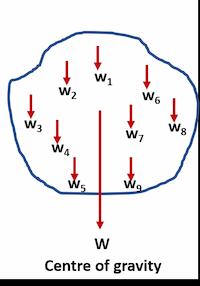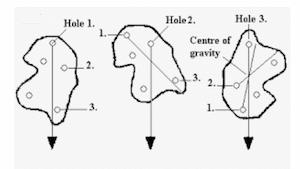The Center of the mass of a system is a position where an applied force causes the system to move without rotation.
A point where the whole weight of the body appears to act vertically downward is called the Center of gravity (COG) of a body.
In the case of the uniform gravitational field, the COG is in the same position as the centre of mass.
Both terms, the centre of gravity and centre of mass tend to often be used interchangeably since they are often at the same location.

Table of Contents
Examples of Centre of Mass and Centre of Gravity
The concepts of center of mass and center of gravity are used in our daily lives in many ways, some examples include:
- Balancing Objects: The center of mass of an object determines its balance. For example, a pencil will balance on its tip if the center of mass is directly above the point of support.
- Sports: In sports such as gymnastics, diving, and figure skating, the center of mass is an important factor in performing various movements and stunts. Athletes must control their center of mass to maintain balance and stability.
- Architecture: The center of gravity is used in the design and construction of buildings, bridges, and other structures to ensure their stability and prevent collapse.
- Vehicles: The center of gravity is an important consideration in the design of vehicles, such as cars and airplanes. The position of the center of gravity affects the stability and handling of the vehicle.
- Physics Experiments: The center of mass is used in physics experiments to measure the properties of objects and determine their motion.
Center of Gravity
A body is made up of a large number of particles as shown in fig.
Earth attracts each of these particles vertically downward towards its centre.
The pull of the earth is equal to its weight.
These forces acting on the particles of a body are almost parallel.
The result of all these parallel forces is a single force equal to the weight of the body.

A point where this resultant force acts vertically towards the centre of the earth is called the centre of gravity (COG) of the body. This point is useful in problems dealing with equilibrium. The COG of gravity of some commonly used shapes is given in the table below.
| Body | Center of gravity (COG) |
| Uniform rod | Center of the rod |
| Round plate | Center of the plate |
| Sphere | Center of the sphere |
| Triangular plate | Point of intersection of medians |
| Cylinder | The central point of axis |
| Square rectangular parallelogram | Point of intersection of diagonals |
Centre of Gravity (Irregular-Shaped Lamina)
A simple method to find the COG of a body is by the use of a plumbline.
A plumbline consists of a small metal bob (lead or brass) supported by a string.
When the bob is suspended freely by the string, it rests in a vertical direction due to its weight acting vertically downward as shown in the figure.
In this state, the centre of gravity of the bob is exactly below its point of suspension.
Experiment
Take an irregular piece of cardboard.
Make holes 1, 2, and 3 as shown in the figure near its edge.
Fix a nail on a wall. Support the cardboard on the nail through one of the holes, so that the cardboard can swing freely about hole 1.
The cardboard will come to rest with its COG just vertically below the nail.
A vertical line from hole 1 can be located using a plumbline hung from the nail.
Mark the line on the cardboard behind the plumb line.

Repeat it by supporting the cardboard from hole 2.
The line will intersect at point G. Similarly, draw another line from hole 3.
Note that this line also passes through G. It will be found that all the vertical lines from holes 1, 2 and 3 have a common point G, this common point G is the COG of the cardboard.
Plumbline
When a heavy body but of a small volume is hung by a string, its weight acts vertically, downwards, due to which the string hangs vertically. This system of weight and string is called plumbline as shown in the above figure.
Bottom Line-Center of Mass
This article explains the centre of mass and centre of gravity of an object along with the method of finding the centre of gravity of an irregular object. We hope that after reading this article you are able to differentiate between both terms. If you have any quest, please feel free to post a comment.
Related Links
Centripetal Acceleration| 9- Easy Examples
Momentum Equation| Definition And Examples
Instantaneous Velocity| Easy Key Points
Mechanical Energy| 7 Daily Life Examples
Mass vs Weight| 5 Easy Examples
- BCl3 Lewis Structure in four simple steps - November 1, 2023
- PH3 Lewis Structure in four simple steps - October 8, 2023
- PF3 Lewis structure in four simple steps - September 24, 2023



